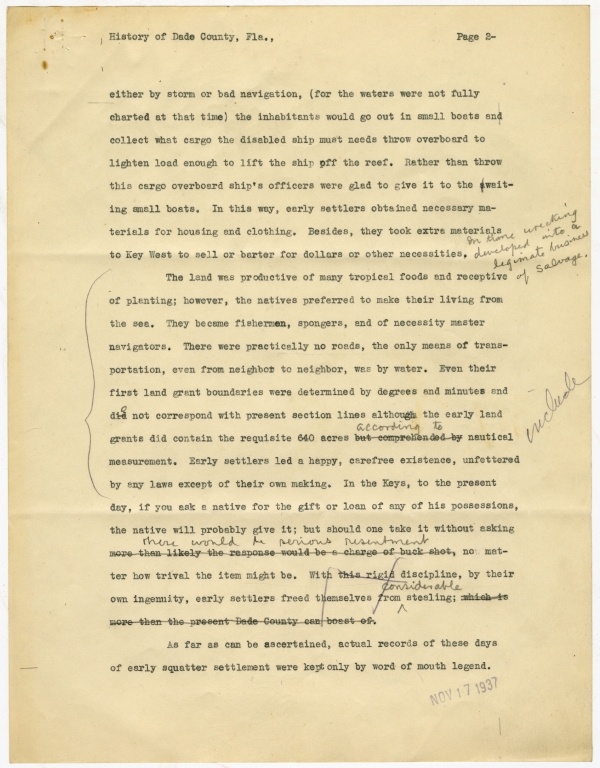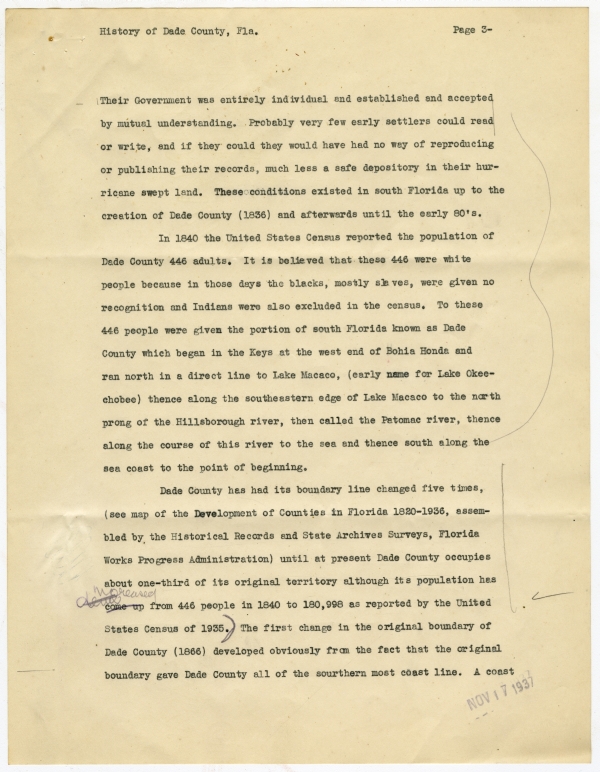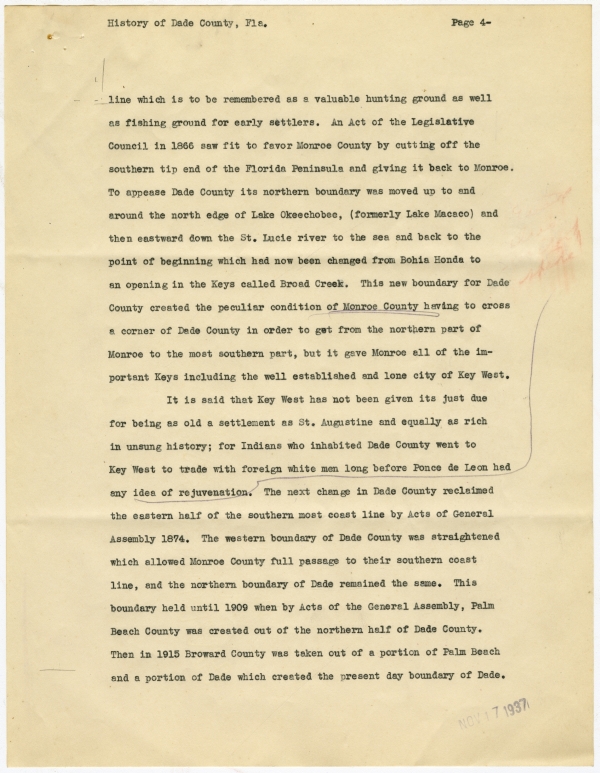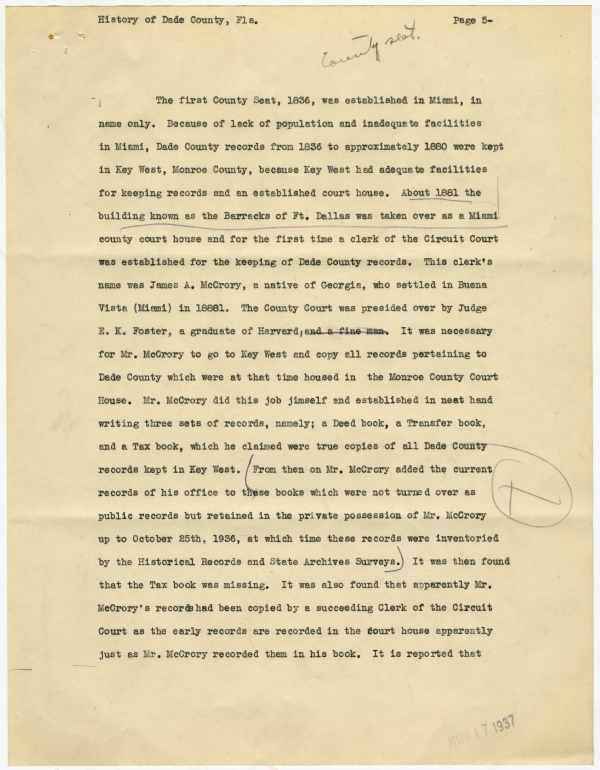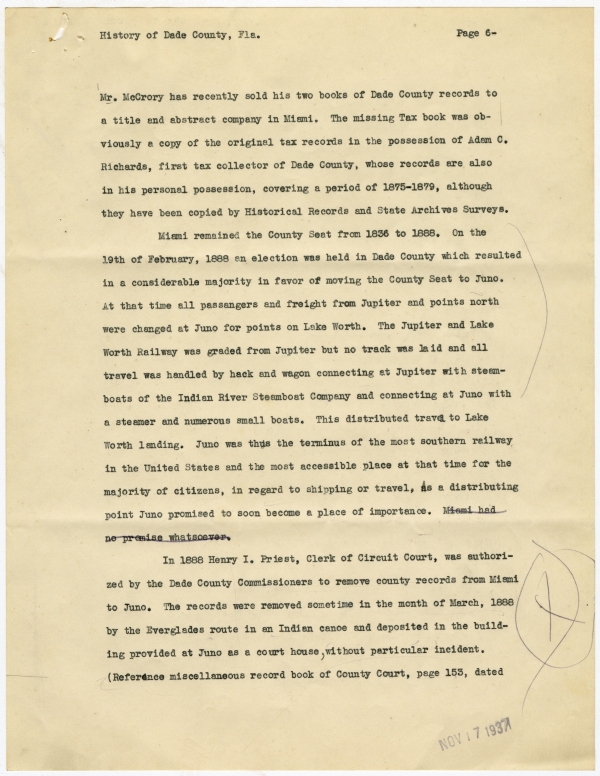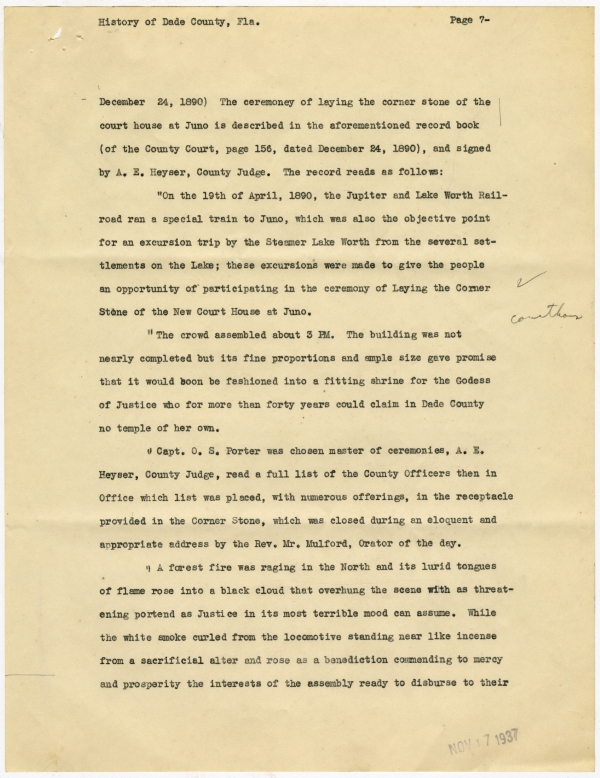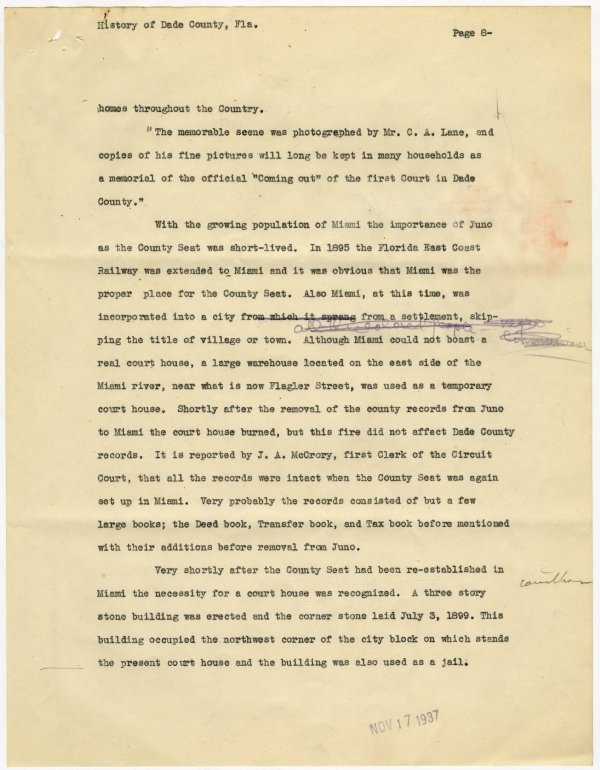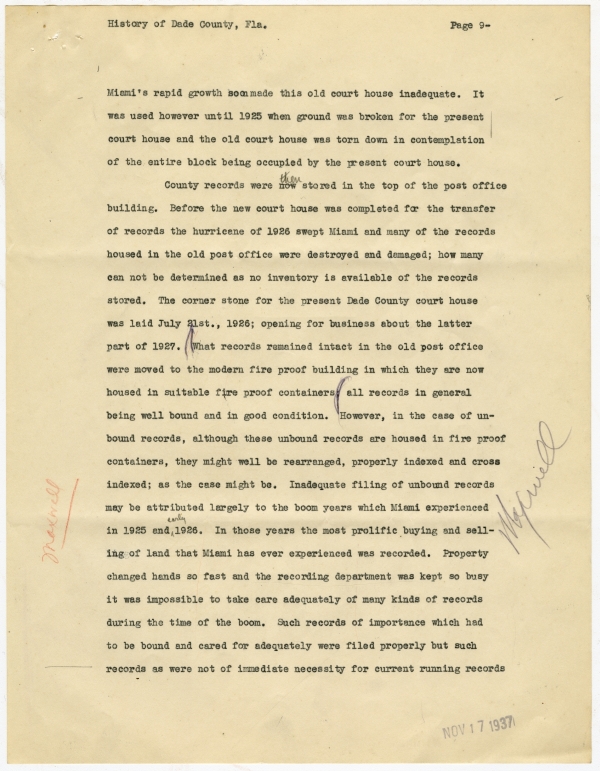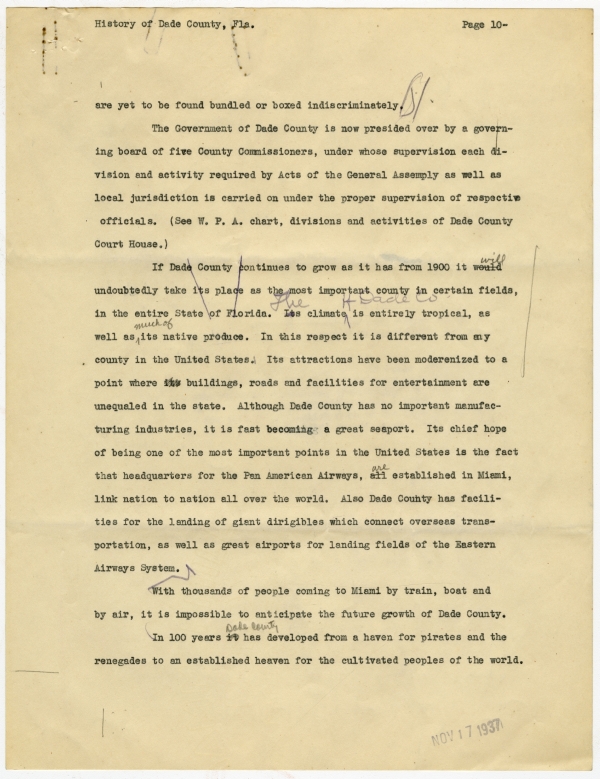Transcript
Natalie Newell
Dist. Supervisor
HRS & SAS
3310 Cornelia Drive
Coconut Grove, Fla.
Approximately 2,500 words
So far as I am able to judge from my own experiences and investigations this paper is OK.
John Gifford
HISTORY OF DADE COUNTY RECORDS
by
NATALIE NEWELL
Long before Dade County was created (by the Laws of Florida, Chapter 937, (XXVI), 1836) the county was speedily but sparingly inhabited, mostly by pirates and renegades. The United States Revenue Cutters from 1809 to 1825 had spelled the doom of piracy along the southern coast of Florida, which was in reality part of the Spanish Main. One by one pirate ships had been either captured or forced on the rocks; their officers and crews taking to small boats or to the water for safety, landing on the southeastern coast line. Once landed, there was little to do but erect what shelter they might and live on the land long enough to obtain squatter's rights to the property.
It may be said in general, that these early inhabitants although they bore the names of pirates and renegade, after settling became respectable citizens despite the fact that search for loot was inherent within them. [In] a legalized manner, the early settlers practiced what was known as "wrecking"-- that is, when a ship was tossed upon a reef,
NOV 17 1937
History of Dade County, Fla.,
Page 2-
either by storm or bad navigation, (for the waters were not fully charted at that time) the inhabitants would go out in small boats and collect what cargo the disabled ship must needs [sic] throw overboard to lighten load enough to lift the ship off the reef. Rather than throw this cargo overboard ship's officers were glad to give it to the waiting small boats. In this way, early settlers obtained necessary materials for housing and clothing. Besides, they took extra materials to Key West to sell or barter for dollars or other necessities. In time wrecking developed into a legitimate business of salvage.
The land was productive of many tropical foods and receptive of planting; however, the natives preferred to make their living from the sea. They became fishermen, spongers, and of necessity master navigators. There were practically no roads, the only means of transportation, even from neighbor to neighbor, was by water. Even their first land grant boundaries were determined by degrees and minutes and do not correspond with present section lines although the early land grants did contain the requisite 640 acres according to nautical measurement. Early settlers led a happy, carefree existence, unfettered by any laws except of their own making. In the Keys, to the present day, if you ask a native for the gift or loan of any of his possessions, the native will probably give it; but should one take it without asking there would be serious resentment, no matter how [trivial] the item might be.
As far as can be ascertained, actual records of these days of early squatter settlement were kept only by word of mouth legend.
NOV 17 1937
History of Dade County, Fla.
Page 3-
Their Government was entirely individual and established and accepted by mutual understanding. Probably very few early settlers could read or write, and if they could they would have had no way of reproducing or publishing their records, much less a safe depository in their hurricane swept land. These conditions existed in south Florida up to the creation of Dade County (1836) and afterwards until the early 80's.
In 1840 the United States Census reported the population of Dade County 446 adults. It is believed that these 446 were white people because in those days the blacks, mostly slaves, were given no recognition and Indians were also excluded in the census. To these 446 people were given the portion of south Florida known as Dade County which began in the Keys at the west end of [Bahia] Honda and ran north in a direct line to Lake Macaco, (early name for Lake Okeechobee) thence along the southeastern edge of Lake Macaco to the north prong of the Hillsborough river, then called the Patomac river, thence along the course of this river to the sea and thence south along the sea coast to the point of beginning.
Dade County has had its boundary line changed five times, (see map of the Development of Counties in Florida 1820-1936, assembled by the Historical Records and State Archives Surveys, Florida Works Progress Administration) until at present Dade County occupies about one-third of its original territory although its population has increased from 446 people in 1840 to 180,998 as reported by the United States Census of 1935.) [sic] The first change in the original boundary of Dade County (1866) developed obviously from the fact that the original boundary gave Dade County all of the [southern] most coast line. A coast
NOV 17 1937
History of Dade County, Fla.
Page 4-
line which is to be remembered as a valuable hunting ground as well as fishing ground for early settlers. An Act of the Legislative Council in 1866 saw fit to favor Monroe County by cutting off the southern tip end of the Florida Peninsula and giving it back to Monroe. To appease Dade County its northern boundary was moved up to and around the north edge of Lake Okeechobee, (formerly Lake Macaco) and then eastward down the St. Lucie river to the sea and back to the point of beginning which had now been changed from [Bahia] Honda to an opening in the Keys called Broad Creek. This new boundary for Dade County created the peculiar condition of Monroe County having to cross a corner of Dade County in order to get from the northern part of Monroe to the most southern part, but it gave Monroe all of the important Keys including the well established and lone city of Key West.
It is said that Key West has not been given its just due for being as old a settlement as St. Augustine and equally as rich in unsung history; for Indians who inhabited Dade County went to Key West to trade with foreign white men long before Ponce de Leon had any idea of rejuvenation. The next change in Dade County reclaimed the eastern half of the southern most coast line by Acts of General Assembly 1874. The western boundary of Dade County was straightened which allowed Monroe County full passage to their southern coast line, and the northern boundary of Dade remained the same. This boundary held until 1909 when by Acts of the General Assembly, Palm Beach County was created out of the northern half of Dade County. Then in 1915 Broward County was taken out of a portion of Palm Beach and a portion of Dade which created the present day boundary of Dade.
NOV 17 1937
History of Dade County, Fla.
Page 5-
County seat.
The first County Seat, 1836, was established in Miami, in name only. Because of lack of population and inadequate facilities in Miami, Dade County records from 1836 to approximately 1880 were kept in Key West, Monroe County, because Key West had adequate facilities for keeping records and an established court house. About 1881 the building known as the Barracks of Ft. Dallas was taken over as a Miami county court house and for the first time a clerk of the Circuit Court was established for the keeping of Dade County records. This clerk's name was James A. McCrory, a native of Georgia, who settled in Buena Vista (Miami) in [1881]. The County Court was presided over by Judge E. K. Foster, a graduate of Harvard. It was necessary for Mr. McCrory to go to Key West and copy all records pertaining to Dade County which were at that time housed in the Monroe County Court House. Mr. McCrory did this job [himself] and established in neat hand writing three sets of records, namely; a Deed book, a Transfer book, and a Tax book, which he claimed were true copies of all Dade County records kept in Key West. (From then on Mr. McCrory added the current records of his office to these books which were not turned over as public records but retained in the private possession of Mr. McCrory up to October 25th, 1936, at which time these records were inventoried by the Historical Records and State Archives Surveys.) It was then found that the Tax book was missing. It was also found that apparently Mr. McCrory's records had been copied by a succeeding Clerk of the Circuit Court as the early records are recorded in the court house apparently just as Mr. McCrory recorded them in his book. It is reported that
NOV 17 1937
History of Dade County, Fla.
Page 6-
Mr. McCrory has recently sold his two books of Dade County records to a title and abstract company in Miami. The missing Tax book was obviously a copy of the original tax records in the possession of Adam C. Richards, first tax collector of Dade County, whose records are also in his personal possession, covering a period of 1875-1879, although they have been copied by Historical Records and State Archives Surveys.
Miami remained the County Seat from 1836 to 1888. On the 19th of February, 1888 an election was held in Dade County which resulted in a considerable majority in favor of moving the County Seat to Juno. At that time all [passengers] and freight from Jupiter and points north were changed at Juno for points on Lake Worth. The Jupiter and Lake Worth Railway was graded from Jupiter but no track was laid and all travel was handled by hack and wagon connecting at Jupiter with steamboats of the Indian River Steamboat Company and connecting at Juno with a steamer and numerous small boats. This distributed travel to Lake Worth landing. Juno was thus the terminus of the most southern railway in the United States and the most accessible place at that time for the majority of citizens, in regard to shipping or travel. As a distributing point Juno promised to soon become a place of importance.
In 1888 Henry I. Priest, Clerk of Circuit Court, was authorized by the Dade County Commissioners to remove county records from Miami to Juno. The records were removed sometime in the month of March, 1888 by the Everglades route in an Indian canoe and deposited in the building provided at Juno as a court house, without particular incident. (Reference miscellaneous record book of County Court, page 153, dated
NOV 17 1937
History of Dade County, Fla.
Page 7-
December 24, 1890) The ceremony of laying the corner stone of the court house at Juno is described in the aforementioned record book (of the County Court, page 156, dated December 24, 1890), and signed by A. E. Heyser, County Judge. The record reads as follows:
"On the 19th of April, 1890, the Jupiter and Lake Worth Railroad ran a special train to Juno, which was also the objective point for an excursion trip by the Steamer Lake Worth from the several settlements on the Lake; these excursions were made to give the people an opportunity of partcipating in the ceremony of Laying the Corner Stone of the New Court House at Juno.
"The crowd assembled about 3 PM. The building was not nearly completed but its fine proportions and ample size gave promise that it would soon be fashioned into a fitting shrine for the Godess of Justice who for more than forty years could claim in Dade County no temple of her own.
"Capt. O. S. Porter was chosen master of ceremonies, A. E. Heyser, County Judge, read a full list of the County Officers then in Office which list was placed, with numerous offerings, in the receptacle provided in the Corner Stone, which was closed during an eloquent and appropriate address by the Rev. Mr. Mulford, Orator of the day.
"A forest fire was raging in the North and its lurid tongues of flame rose into a black cloud that overhung the scene with as threatening portend as Justice in its most terrible mood can assume. While the white smoke curled from the locomotive standing near like incense from a sacrificial [altar] and rose as a benediction commending to mercy and prosperity the interests of the assembly ready to disburse to their
NOV 17 1937
History of Dade County, Fla.
Page 8-
homes throughout the Country.
"The memorable scene was photographed by Mr. C. A. Lane, and copies of his fine pictures will long be kept in many households as a memorial of the official "Coming out" of the first Court in Dade County."
With the growing population of Miami the importance of Juno as the County Seat was short-lived. In 1895 the Florida East Coast Railway was extended to Miami and it was obvious that Miami was the proper place for the County Seat. Also Miami, at this time, was incorporated into a city from a settlement, skipping the title of village or town. Although Miami could not boast a real court house, a large warehouse located on the east side of the Miami river, near what is now Flagler Street, was used as a temporary court house. Shortly after the removal of the county records from Juno to Miami the court house burned, but this fire did not affect Dade County records. It is reported by J. A. McCrory, first Clerk of the Circuit Court, that all the records were intact when the County Seat was again set up in Miami. Very probably the records consisted of but a few large books; the Deed book, Transfer book, and Tax book before mentioned with their additions before removal from Juno.
Very shortly after the County Seat had been re-established in Miami the necessity for a court house was recognized. A three story stone building was erected and the corner stone laid July 3, 1899. This building occupied the northwest corner of the city block on which stands the present court house and the building was also used as a jail.
NOV 17 1937
History of Dade County, Fla.
Page 9-
Miami's rapid growth soon made this old court house inadequate. It was used however until 1925 when ground was broken for the present court house and the old court house was torn down in contemplation of the entire block being occupied by the present court house.
County records were then stored in the top of the post office building. Before the new court house was completed for the transfer of records the hurricane of 1926 swept Miami and many of the records housed in the old post office were destroyed and damaged; how many can not be determined as no inventory is available of the records stored. The corner stone for the present Dade County court house was laid July 21st., 1926; opening for business about the latter part of 1927. What records remained intact in the old post office were moved to the modern fire proof building in which they are now housed in suitable fire proof containers; all records in general being well bound and in good condition. However, in the case of unbound records, although these unbound records are housed in fire proof containers, they might well be rearranged, properly indexed and cross indexed; as the case might be. Inadequate filing of unbound records may be attributed largely to the boom years which Miami experienced in 1925 and early 1926. In those years the most prolific buying and selling of land that Miami has ever experienced was recorded. Property changed hands so fast and the recording department was kept so busy it was impossible to take care adequately of many kinds of records during the time of the boom. Such records of importance which had to be bound and cared for adequately were filed properly but such records as were not of immediate necessity for current running records
Maxwell
NOV 17 1937
History of Dade County, Fla.
Page 10-
are yet to be found bundled or boxed indiscriminately.
The Government of Dade County is now presided over by a governing board of five County Commissioners, under whose supervision each division and activity required by Acts of the General [Assembly] as well as local jurisdiction is carried on under the proper supervision of respective officials. (See W. P. A. chart, divisions and activities of Dade County Court House.)
If Dade County continues to grow as it has from 1900 it will undoubtedly take its place as the most important county in certain fields, in the entire State of Florida. The climate of Dade Co. is entirely tropical, as well as much of its native produce. In this respect it is different from any county in the United States. Its attractions have been [modernized] to a point where buildings, roads and facilities for entertainment are unequaled in the state. Although Dade County has no important manufacturing industries, it is fast becoming a great seaport. Its chief hope of being one of the most important points in the United States is the fact that headquarters for the Pan American Airways, are established in Miami, link nation to nation all over the world. Also Dade County has facilities for the landing of giant dirigibles which connect overseas transportation, as well as great airports for landing fields of the Eastern Airways System.
With thousands of people coming to Miami by train, boat and by air, it is impossible to anticipate the future growth of Dade County.
In 100 years Dade County has developed from a haven for pirates and the renegades to an established heaven for the cultivated peoples of the world.
NOV 17 1937

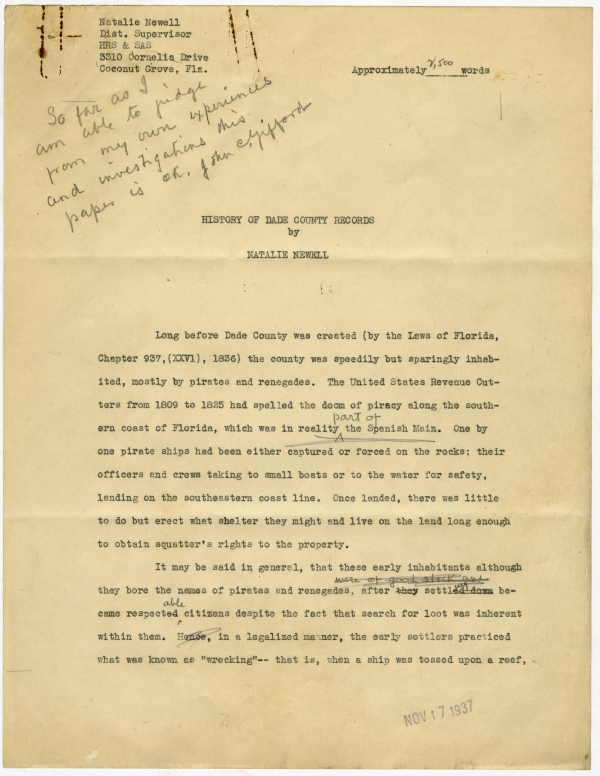


 Listen: The FolkFolk Program
Listen: The FolkFolk Program